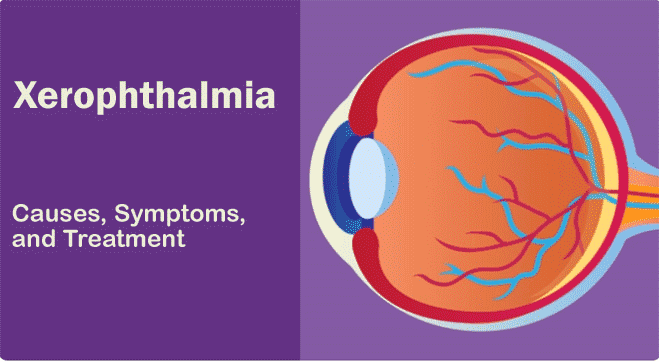You must have always heard how important it is to have a balanced diet. But should it just comprise carbohydrates, proteins, and fats?
No, vitamins play a key role in your body too, and there are several vitamin groups that one must include in their diets for their well-being. The lack of vitamins and minerals in the body can cause several diseases or chronic conditions, some of which are easily detectable while some aren’t.
One such vitamin A deficiency is called xerophthalmia, a condition in the eyes that rises due to the lack of vitamin A in the body. The overall incidence of this condition in India is 5.4%, where symptoms of the same, like Bitot’s spots, were nearly 3.3% in older children. 1
Xerophthalmia can cause a dry eyes condition, improper vision, or even lesions in one’s eyes and can be serious if not treated on time. The solution? Timely xerophthalmia diagnosis followed by consulting a medical professional is also crucial, as well as a diet for vitamin A deficiency. Treatment for xerophthalmia also includes administering antibiotics or oral VAs as prescribed by the World Health Organization, which can help one overcome the condition.
Are you facing symptoms of vitamin A deficiency and are afraid it might be xerophthalmia? Read on to know more about the condition, its causes, symptoms, and prognosis.
What is Xerophthalmia?
Xerophthalmia is a condition in one’s eyes caused by vitamin A deficiency. The condition can lead to dryness of the eyes and blindness, accompanied by other signs and symptoms that need immediate medical attention. At the same time, initial symptoms of xerophthalmia include dryness of the eyes and difficulty seeing. Serious or advanced stages can lead to corneal and retinal damage.2
The most predominant reason for xerophthalmia is vitamin A deficiency, which can be treated by taking supplements or altering one’s diet. However, advanced stages need serious medical attention.
Causes of Xerophthalmia
One of the most predominant causes of night blindness is vitamin A deficiency. Vitamin A is not produced by the body in enough quantities and hence needs to be taken from external sources so that the body can absorb it. While vitamin A plays a key role in the well-being of your heart, kidneys, and lungs, it also maintains your eye health. In fact, it helps the eyes to absorb light in the retina.3
Hence, symptoms of vitamin A deficiency can lead to obstruction in one’s vision, blurred eyesight, or night blindness.
Symptoms of Xerophthalmia
Symptoms of Vitamin A deficiency or xerophthalmia include the following: 4
- Night Blindness: Night blindness causes difficulty or poor vision in low-lit areas. If you are suffering from vitamin A deficiency, you might have trouble adjusting to any changes in lightning. Such issues magnify when you watch a movie in the theatre or in a restaurant where your surroundings are relatively darker.
- Xerophthalmia Fundus: Xerophthalmia symptoms include sores in one’s retina along with a change in its structure, which in turn affects one’s vision.
- Conjunctival Xerosis: Conjunctival xerosis is a dry eye condition resulting from xerophthalmia. The conjunctiva is a membrane that protects the sclera of your eyes, and as the name suggests, it causes your conjunctiva to dry up. Dry eyes condition can be treated using various kinds of drops that keep your conjunctiva lubricated and hydrated.
- Bitot Spots: Vitamin A deficiency can also lead to the formation of triangular spots on the sclera of your eyes and is one of the first xerophthalmia symptoms.
- Corneal Xerosis: Just like conjunctival xerosis, a dry eyes condition can also arise from corneal xerosis, or the drying up of the cornea. It is a protective layer of your eyes and is mostly lubricated. However, xerophthalmia or vitamin A deficiency can lead to the drying up of the same. In severe cases, xerophthalmia symptoms can also include corneal ulcers, which cause minute holes in the cornea and difficulty in vision.
Diagnosis of Xerophthalmia
If you think you might be facing xerophthalmia symptoms, it would be best to contact an ophthalmologist. While vitamin A eye problems are not rare, it is vital to figure out the condition you might have and take proper treatment for it. Thus, an ophthalmologist might prescribe you a Vitamin A test to check your levels, followed by suggesting the appropriate treatment for the same.5
Risk Factors of Xerophthalmia
Vitamin A and eye health are very closely related, and anyone with a lack of vitamin A is susceptible to xerophthalmia, or dry eyes condition. However, some groups and individuals are more prone to the same. Here are some of the age groups and other criteria that increase its chances.
- Age: Xerophthalmia is more common in infants or children. Vitamin A deficiency can not only impact their overall growth and affect several organs but also cause childhood blindness, dry eye conditions, and much more. For instance, children between 3-6 are more susceptible to night blindness than adults. While individuals need a specific diet for Vitamin A deficiency, there are several other factors that lead to xerophthalmia in children. For instance, children suffering from diseases like respiratory disorders or measles can increase their chances of xerophthalmia.
- Poverty: Social factors like poverty are also one of the causes of xerophthalmia. People who cannot afford a proper diet for vitamin A deficiency can be more susceptible to the condition.
- Liver Diseases: Liver diseases like cirrhosis can lower the absorption rate of vitamin A and lead to xerophthalmia symptoms in individuals. Other conditions like inflammatory bowel syndrome and chronic diarrhoea can also lead to improper vitamin A absorption, leading to the condition.
Treatment of Xerophthalmia
Dry eyes condition can be treated if it is detected soon and you take proper medical help. Xerophthalmia diagnosis varies depending on its stage, age, and much more. For instance, children suffering from the condition should be immediately taken to the doctor and given oral VA.
In cases where xerophthalmia symptoms include corneal lesions, the doctor might administer antibiotics like chloramphenicol or tetracycline. These antibiotics not only heal the lesions but also prevent any kind of infection. Treatment for xerophthalmia affecting the cornea, also known as corneal xerophthalmia, typically continues for 4 weeks. However, the treatment also depends on the size and thickness of the lesions formed in the cornea. 6
If you suffer from mild xerophthalmia symptoms, the doctor might also prescribe vitamin A supplements to boost its level in your body. Remember, vitamin A provides the moisture to lubricate your eyes, especially the cornea, conjunctiva, and retina. It is because of the lack of Vitamin A that these tend to dry up, ultimately leading to blindness. Hence, taking Vitamin A supplements helps your body replenish the deficit and increase its levels in your bloodstream. To sum up, xerophthalmia diagnosis should be immediately followed up by treatment and other changes in the diet for vitamin A deficiency.
Prevention of Xerophthalmia
Night blindness causes include improper diets and most vitamin A deficiency. Thus, in order to prevent xerophthalmia, one should take a proper diet for Vitamin A deficiency besides having a properly balanced diet. This includes having high quantities of dark leafy vegetables, yellow and orange fruits, and vegetables like papaya, pumpkin, carrots, and oranges. Animal sources like fish oil, liver, and eggs can also be rich sources of Vitamin A and can help you avoid Vitamin A deficiency eye problems.
Xerophthalmia diagnosis at the right time is also important, especially amongst children. So, if your child faces any difficulty in their vision, especially at night, testing for their Vitamin A levels is vital. After all, it’s better to be careful than sorry!
Risk Factors and Populations Most Affected
There is a close correlation between Vitamin A and eye health, where the lack of the former can deteriorate the latter. One of the major causes of night blindness is vitamin A deficiency, and it can affect certain demographic groups more than others. As mentioned below, children are at a higher risk of xerophthalmia. However, the income of individuals, their lifestyle, and where they stay also play a key role in the causes of xerophthalmia.
For instance, individuals living in rural areas might not be aware of the micro- and macro-nutrition required in their daily meals, and therefore, Vitamin A deficiency is more prevalent in such areas.
Secondly, children between the age groups of 3-6 and pregnant women are also at a higher risk of the condition. Apart from other biological reasons, these groups are mostly “picky” eaters and therefore miss including major nutrition in their diets and might face xerophthalmia symptoms.
Lastly, unlike popular vitamin groups like Vitamin C and Vitamin D, there exists a lack of awareness regarding vitamin A, and therefore, individuals often do not consider including specific food items in their diet for vitamin A deficiency. Such lack of awareness or education related to dietary habits is even more popular in rural areas. Such lifestyles are also deeply connected to the livelihood of the people. For instance, people in rural areas are mostly involved in agriculture or manual labour and tend to consume more carbohydrates, which are a direct source of energy. Hence, their meals do not contain equal amounts of all the nutrients required by the body, increasing the causes of xerophthalmia.
It has also been seen that the incidence of xerophthalmia is higher in rice-consuming countries and within the lower socio-economic groups who fail to understand the connection between nutrients and their benefits and, therefore, avoid eating fruits and vegetables, which could have otherwise replenished vitamin A deficiency in them. 7
Conclusion
Xerophthalmia is a condition resulting from a deficiency in vitamin A and can lead to night blindness and difficulties in one’s vision. Though the condition is more common amongst infants and children, all individuals with a lack of vitamin A are prone to it. Xerophthalmia diagnosis includes reaching out to a medical practitioner, followed by taking a vitamin A test to check for its levels. If your doctor thinks that the Vitamin A levels are lower than usual, you might be administered antibiotics or oral VAs, depending on your age and the seriousness of the condition.
While treatment for xerophthalmia can help you cure the condition, there are several ways to prevent the same from occurring as well. Intake of green leafy vegetables, fish protein, and certain fruits like squash and pumpkin can help boost your body’s Vitamin A. Moreover, awareness regarding the importance of Vitamin A and its benefits also plays a crucial role in tackling xerophthalmia. For instance, people in rural areas must be educated on having a balanced diet or the dietary changes they should implement in order to overcome such conditions.
Summing up, vitamin A deficiency eye problems can be serious if not treated immediately, and hence it is vital to ensure proper and timely xerophthalmia diagnosis and treatment.








